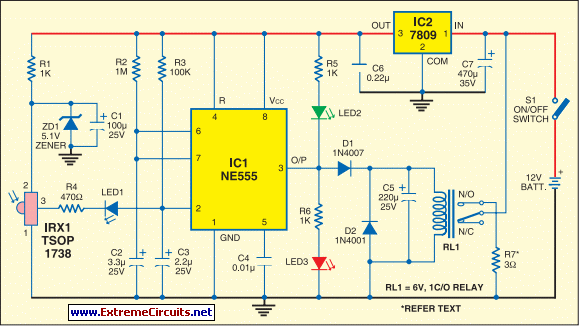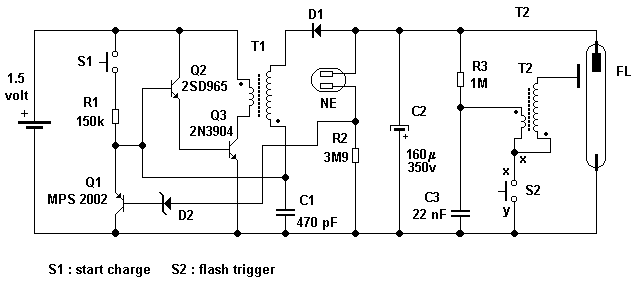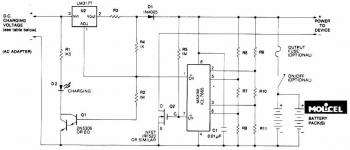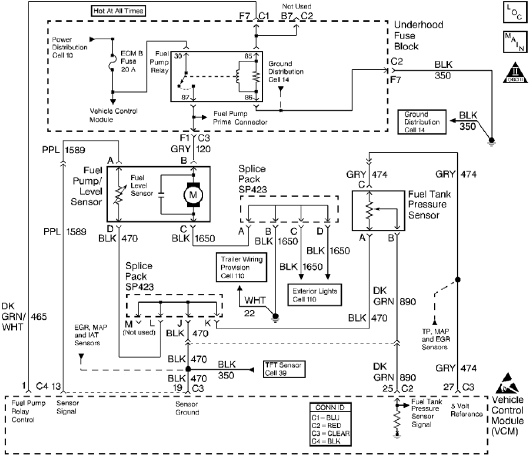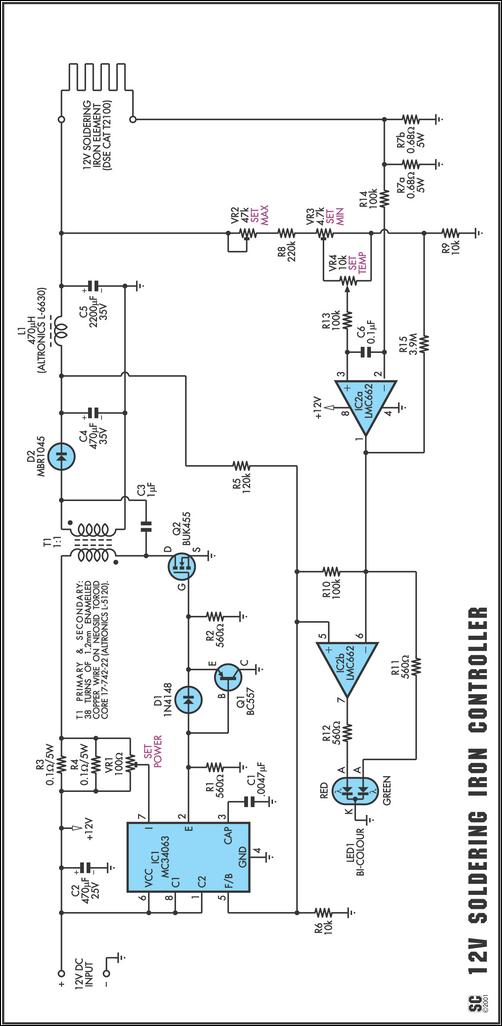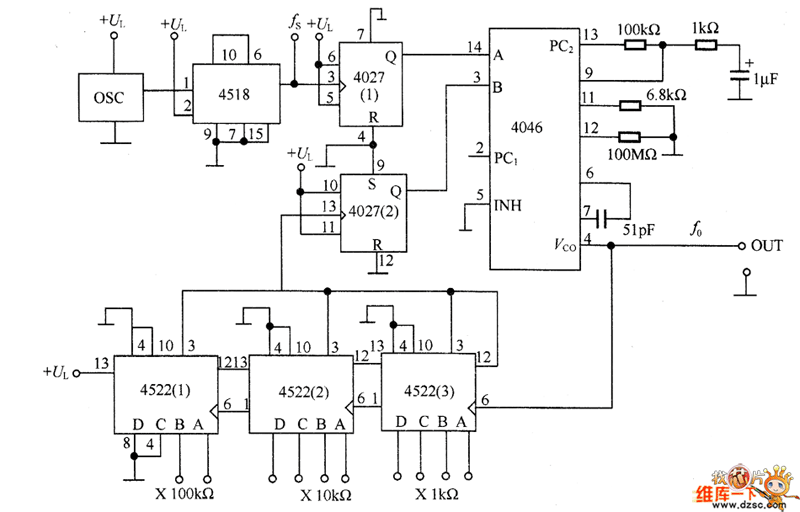
Bots Circuit Designs
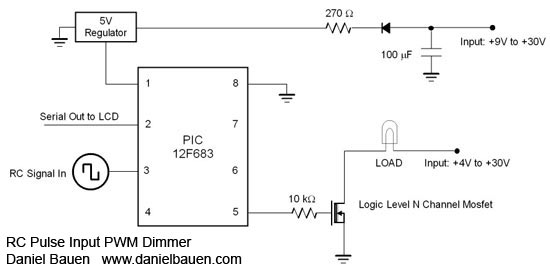
A PIC12F675 microcontroller can switch up to five outputs sequentially using a standard Remote Control pulse input ranging from 1 to 2 ms. While any RC channel input can be utilized, it is particularly effective when paired with rotary knob channels, typically channels five and above on RC airplane remotes. The knob can be adjusted to a specific position, determining which output relay will be activated. The example circuit illustrated below switches between three inputs to one output. Various configurations can be developed for specific applications. A larger PIC microcontroller could be employed for additional switching outputs. This circuit is beneficial for Pulse Width Modulation (PWM) of a load using a standard Remote Control pulse input of 1 to 2 ms. It can serve as a simple motor speed controller or to adjust the brightness of a light or other loads requiring variable voltage. The PIC12F683 is well-suited for this application, as it is a compact microcontroller equipped with a hardware pulse width modulation channel (HPWM). This feature allows the PWM signal to operate in the background while the microcontroller executes other code, ensuring that the PWM output is not influenced by the duration of program loop execution.
The circuit design utilizing the PIC12F675 or PIC12F683 microcontroller focuses on creating a versatile control system that can manage various loads through PWM. The microcontroller's ability to interpret short pulse widths from a remote control enables it to effectively switch outputs based on user input. The configuration can be adjusted to accommodate different numbers of outputs, depending on application needs.
In a typical setup, the microcontroller receives a pulse width signal from the remote control, which is processed to determine the desired output state. The rotary knob on the remote allows for smooth transitions between different output relays, providing an intuitive user interface. This is particularly advantageous in applications such as model aircraft, where precise control over motor speed or light intensity is required.
The implementation of PWM through the PIC12F683's HPWM feature allows for efficient management of power to the load. This is crucial in applications where energy conservation and heat management are important. The HPWM channel operates independently of the main program execution, enabling the microcontroller to perform other tasks without interrupting the PWM signal.
For a practical application, the circuit can be designed to control a DC motor, where the PWM signal adjusts the average voltage supplied to the motor, thus controlling its speed. Similarly, for lighting applications, the PWM can modulate the brightness of LED lights by varying the duty cycle of the signal, leading to a range of brightness levels without the need for bulky resistive dimmers.
Overall, this circuit exemplifies the integration of microcontroller technology with remote control systems, providing a flexible solution for various electronic control applications. The ability to customize the circuit for different outputs and loads makes it an ideal choice for hobbyists and engineers alike.Using a PIC12F675, up to 5 outputs can be switched sequentially using a standard Remote Control pulse input of between 1 to 2 ms. Although any RC channel input can be used, it is especially useful when used with the rotary knob channels (usually 5 and above on RC airplane remote).
The knob can be rotated to a certain position, selecting which outp ut relay will be turned on. The example circuit shown below switches between 3 inputs to 1 output. Many different configurations could be created for specific applications. A larger PIC could be used for more switching outputs. This is a useful circuit for Pulse Width Modulation of a load using a standard Remote Control pulse input of between 1 to 2 ms. The circuit can be used as a simple motor speed controller, or to control the brightness of a light, or other loads that need a variable voltage.
The PIC12F683 is ideal for this purpose, because it is a small microcontroller, that has a hardware pulse width modulation channel (HPWM). This means that the PWM signal runs in the background while the microcontroller processes the rest of the code.
So the PWM output is not dependent on the length of time it takes to execute a program loop. 🔗 External reference
The circuit design utilizing the PIC12F675 or PIC12F683 microcontroller focuses on creating a versatile control system that can manage various loads through PWM. The microcontroller's ability to interpret short pulse widths from a remote control enables it to effectively switch outputs based on user input. The configuration can be adjusted to accommodate different numbers of outputs, depending on application needs.
In a typical setup, the microcontroller receives a pulse width signal from the remote control, which is processed to determine the desired output state. The rotary knob on the remote allows for smooth transitions between different output relays, providing an intuitive user interface. This is particularly advantageous in applications such as model aircraft, where precise control over motor speed or light intensity is required.
The implementation of PWM through the PIC12F683's HPWM feature allows for efficient management of power to the load. This is crucial in applications where energy conservation and heat management are important. The HPWM channel operates independently of the main program execution, enabling the microcontroller to perform other tasks without interrupting the PWM signal.
For a practical application, the circuit can be designed to control a DC motor, where the PWM signal adjusts the average voltage supplied to the motor, thus controlling its speed. Similarly, for lighting applications, the PWM can modulate the brightness of LED lights by varying the duty cycle of the signal, leading to a range of brightness levels without the need for bulky resistive dimmers.
Overall, this circuit exemplifies the integration of microcontroller technology with remote control systems, providing a flexible solution for various electronic control applications. The ability to customize the circuit for different outputs and loads makes it an ideal choice for hobbyists and engineers alike.Using a PIC12F675, up to 5 outputs can be switched sequentially using a standard Remote Control pulse input of between 1 to 2 ms. Although any RC channel input can be used, it is especially useful when used with the rotary knob channels (usually 5 and above on RC airplane remote).
The knob can be rotated to a certain position, selecting which outp ut relay will be turned on. The example circuit shown below switches between 3 inputs to 1 output. Many different configurations could be created for specific applications. A larger PIC could be used for more switching outputs. This is a useful circuit for Pulse Width Modulation of a load using a standard Remote Control pulse input of between 1 to 2 ms. The circuit can be used as a simple motor speed controller, or to control the brightness of a light, or other loads that need a variable voltage.
The PIC12F683 is ideal for this purpose, because it is a small microcontroller, that has a hardware pulse width modulation channel (HPWM). This means that the PWM signal runs in the background while the microcontroller processes the rest of the code.
So the PWM output is not dependent on the length of time it takes to execute a program loop. 🔗 External reference
